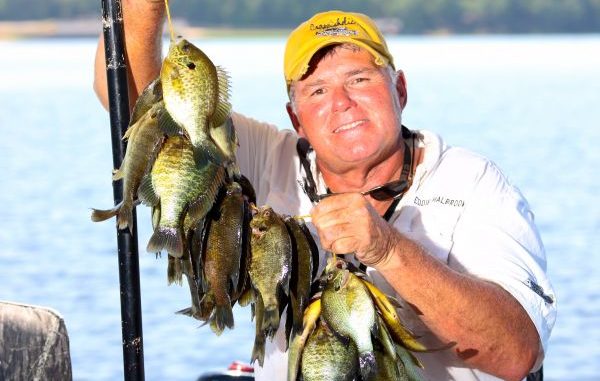
I could hardly find the boat ramp at Grand Bayou near Coushatta because there was no long line of boats waiting to launch.
There were no boats blasting away from the ramp.
Heck there weren’t even any trucks in the parking lot except for one, and it belonged to North Louisiana fishing guide Eddie Halbrook.
Being that it was Tuesday, it didn’t surprise me all that much that we were the only ones fishing. As far as I knew, there wasn’t anything really biting other than chinquapin, and in a state known for largemouth bass, white perch, speckled trout and redfish, chinquapin don’t get much attention.
But as far as Halbrook and I are concerned, there is no guilty pleasure any guiltier than catching chinquapin.
I expected that we were going to be fishing for bedding fish with crickets under corks, but that wasn’t the case.
“These fish are moving up to spawn, but they aren’t there yet,” Halbrook told me as we idled away from the ramp at Grand Bayou Resort. “Right now, they’re staged up anywhere from 4 to 8 feet of water, and I’m catching them on a drop shot and tightline.”
And instead of crickets, Halbrook brought along several tubs of cold worms.
Also known as shell crackers, chinquapin are known for feeding on mussels piled up at the bottom of a lake, and those that inhabit Grand Bayou Reservoir are no exception.
Halbrook’s plan was to put our cold worms right on the bottom over the largest concentration of mussel shells.
We started out fishing down by the lake dam, but the wind made it too tough to stay put, so we moved up closer to the LA 784 bridge in hopes that it would act as a buffer.
Halbrook rigged three spinning reels with drop-shot rigs using #4 hooks and #5 split-shot weights.
“The reason I use a #4 hook is because I can get a lot more of that cold worm on it,” Halbrook explained. “It seems like the more cold worm I put on it the better the fish bite it.”
He tied a regular Trilene knot to the hook while leaving about a 10-inch long tag end to which he clamped on the two split shots.
“Tie a little knot on the end of your line so they won’t slide off as bad,” Halbrook went on. “I try to stay under a foot… I’m about 9 inches on this one. If they’re not biting it good on that, all I got to do is shorten it up by sliding the weights up.”
More poles in the water means more chances to catch fish, so Halbrook rigged up some Little Jewel jig poles with a standard tightline rig with the weight above the hook and put them in rod holders at the corners of his boat.
We caught chinquapin after chinquapin for the next several hours, and as Halbrook had predicted earlier that morning, our best bite came as the sun got really high and the day got hotter and hotter.
And our best presentation was to cast our drop-shot rigs out with the spinning rods and crawl them slowly across the bottom. When we really got in them, the chinquapin inhaled our worms before they even hit bottom.
“This is July 31 and we’re out here smoking these redears,” Halbrook concluded. “And it’s only going to get better into August when they actually start spawning. The funny thing is, I’m likely to be the only one out here then, too.”
For more information, contact Eddie Halbrook at 318-548-1375.